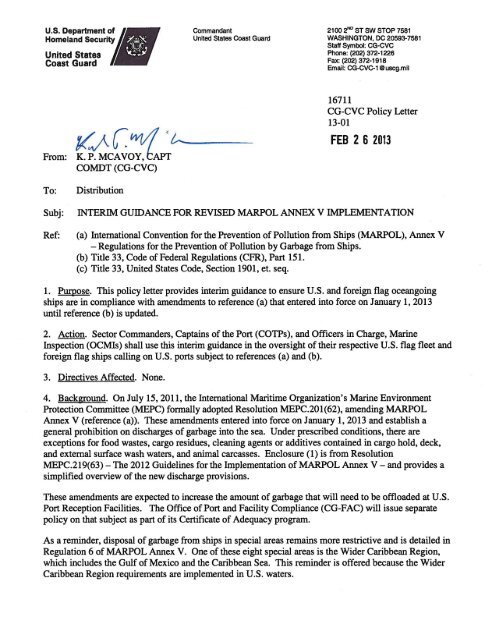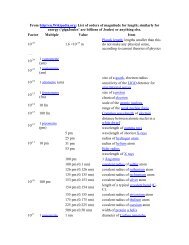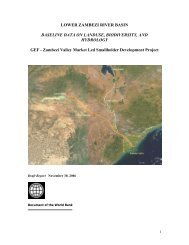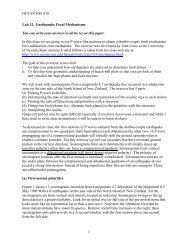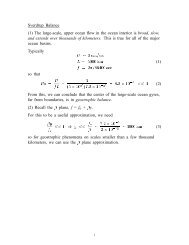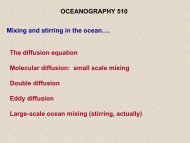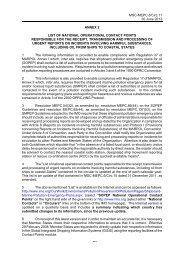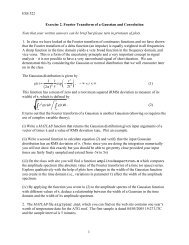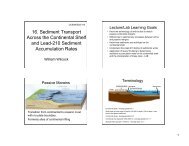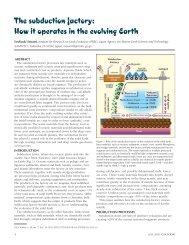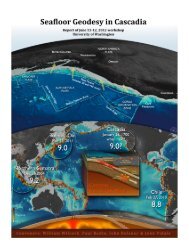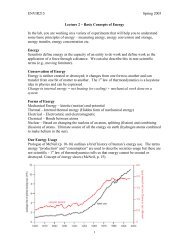USCG MARPOL Annex V Guidelines 2013 Feb
USCG MARPOL Annex V Guidelines 2013 Feb
USCG MARPOL Annex V Guidelines 2013 Feb
You also want an ePaper? Increase the reach of your titles
YUMPU automatically turns print PDFs into web optimized ePapers that Google loves.
U.S. Departmento~.<br />
Homeland Security<br />
United States<br />
Coast Guard<br />
Commandant<br />
United States Coast Guard<br />
2100 2 ND ST SW STOP 7581<br />
WASHINGTON, DC 20593-7581<br />
Staff Symbol: CG-CVC<br />
Phone: (202) 372-1226<br />
Fax: (202) 372-1918<br />
Email: CG-CVC-1@uscg.mil<br />
From:<br />
To:<br />
¥JrWf/! (t-.__<br />
K. P. MCAVO;' bAPT<br />
COMDT (CG-CVC)<br />
Distribution<br />
16711<br />
CG-CVC Policy Letter<br />
13-01<br />
FEB 2 6 <strong>2013</strong><br />
Subj:<br />
Ref:<br />
INTERIM GUIDANCE FOR REVISED <strong>MARPOL</strong> ANNEX V IMPLEMENTATION<br />
(a) International Convention for the Prevention ofPollution from Ships (<strong>MARPOL</strong>), <strong>Annex</strong> V<br />
- Regulations for the Prevention ofPollution by Garbage from Ships.<br />
(b) Title 33, Code of Federal Regulations (CPR), Part 151.<br />
(c) Title 33, United States Code, Section 1901, et. seq.<br />
1. Purpose. This policy letter provides interim guidance to ensure U.S. and foreign flag oceangoing<br />
ships are in compliance with amendments to reference (a) that entered into force on January 1,<strong>2013</strong><br />
until reference (b) is updated.<br />
2. Action. Sector Commanders, Captains of the Port (COTPs), and Officers in Charge, Marine<br />
Inspection (OCMIs) shall use this interim guidance in the oversight oftheir respective U.S. flag fleet and<br />
foreign flag ships calling on U.S. ports subject to references (a) and (b).<br />
3. Directives Affected. None.<br />
4. Background. On July 15,2011, the International Maritime Organization's Marine Environment<br />
Protection Committee (MEPC) formally adopted Resolution MEPC.201(62), amending <strong>MARPOL</strong><br />
<strong>Annex</strong> V (reference (a)). These amendments entered into force on January 1,<strong>2013</strong> and establish a<br />
general prohibition on discharges of garbage into the sea. Under prescribed conditions, there are<br />
exceptions for food wastes, cargo residues, cleaning agents or additives contained in cargo hold, deck,<br />
and external surface wash waters, and animal carcasses. Enclosure (1) is from Resolution<br />
MEPC.219(63) - The 2012 <strong>Guidelines</strong> for the Implementation of <strong>MARPOL</strong> <strong>Annex</strong> V - and provides a<br />
simplified overview of the new discharge provisions.<br />
These amendments are expected to increase the amount of garbage that will need to be offloaded at U.S.<br />
Port Reception Facilities. The Office ofPort and Facility Compliance (CG-FAC) will issue separate<br />
policy on that subject as part of its Certificate of Adequacy program.<br />
As a reminder, disposal of garbage from ships in special areas remains more restrictive and is detailed in<br />
Regulation 6 of <strong>MARPOL</strong> <strong>Annex</strong> V. One of these eight special areas is the Wider Caribbean Region,<br />
which includes the Gulf of Mexico and the Caribbean Sea. This reminder is offered because the Wider<br />
Caribbean Region requirements are implemented in U.S. waters.
Subj: INTERIM GUIDANCE FOR REVISED <strong>MARPOL</strong><br />
ANNEX V IMPLEMENTATION<br />
16711<br />
CG-CVC Policy Letter 13-01<br />
<strong>Feb</strong>ruary 26, <strong>2013</strong><br />
5. Discussion. The U.S. implements <strong>MARPOL</strong> 73/78 <strong>Annex</strong> V by the Act to Prevent Pollution from<br />
Ships. Regulations are provided in 33 CFR 151 to assist the regulated community in complying with the<br />
law. However, current regulations are not aligned with the January 1, <strong>2013</strong> entry into force of the<br />
<strong>Annex</strong> V amendments. This policy letter is intended to act as interim guidance until U.S. regulations are<br />
updated.<br />
The lack of updated regulations does not exempt ships from meeting the requirements of <strong>MARPOL</strong><br />
<strong>Annex</strong> V. As of January 1, <strong>2013</strong>, all U.S. ships and platforms, both fixed and floating, are expected to<br />
meet the requirements of the amended <strong>MARPOL</strong> <strong>Annex</strong> V. This is particularly important for U.S. ships<br />
on international voyages, including recreational and uninspected ships, who want to avoid Port State<br />
control actions. All non-U.S. flagged ships operating in the navigable waters of the U.S. or the<br />
Exclusive Economic Zone of the U.S. are expected to meet the requirement of the amended <strong>MARPOL</strong><br />
<strong>Annex</strong> V.<br />
Along with the new discharge requirements outlined in enclosure (1), the following differences between<br />
existing U.S. regulations and the amended <strong>MARPOL</strong> <strong>Annex</strong> V should be noted.<br />
a. Garbage Record Book (33 CFR 151.55 / <strong>MARPOL</strong> <strong>Annex</strong> V (amended) Regulation 10):<br />
While the applicability has not changed, there are notable changes in the general reporting<br />
format of the garbage record book to account for the increased restrictions on the discharge of<br />
garbage into the sea. The garbage record book, whether as part of the ship’s official logbook or<br />
otherwise, shall be in the form specified in Resolution MEPC.201(62). Operators are<br />
encouraged to print the example provided in enclosure (2) for use.<br />
b. Waste Management Plan (33 CFR 151.57 / <strong>MARPOL</strong> <strong>Annex</strong> V (amended) Regulation 10):<br />
Requirements for domestic oceangoing ships have not changed. However, the applicability for<br />
non-U.S. flagged ships that engage in international voyages has been reduced from 400 gross<br />
tonnage and above to 100 gross tonnage and above. Garbage management plans should reflect<br />
the collecting, on board storage, and final disposition of garbage per the revised requirements.<br />
c. Placards (33 CFR 151.59 / <strong>MARPOL</strong> <strong>Annex</strong> V (amended) Regulation 10):<br />
While the applicability has not changed, placards must be updated to reflect the new garbage<br />
discharge requirements. Until U.S. regulations are updated to reflect the new garbage discharge<br />
regime and placards are readily available, U.S. flagged ships operating exclusively on domestic<br />
voyages may continue to use existing placards.<br />
U.S. flagged ships on international voyages and visiting ports of a country that are party to<br />
<strong>MARPOL</strong> <strong>Annex</strong> V will need to meet the annex’s placarding requirements to avoid possible port<br />
state control action. Operators are encouraged to make and post copies of the relevant examples<br />
provided in Enclosure (3).<br />
2
Subj: INTERIM GUIDANCE FOR REVISED <strong>MARPOL</strong><br />
ANNEX V IMPLEMENTATION<br />
16711<br />
CG-CVC Policy Letter 13-01<br />
<strong>Feb</strong>ruary 26, <strong>2013</strong><br />
6. Enforcement. Coast Guard Port State Control officers should verify a foreign flag ship’s compliance<br />
with <strong>MARPOL</strong> <strong>Annex</strong> V during normally scheduled Port State Control examinations. For U.S. ships<br />
operating strictly on domestic routes, compliance should be verified by Coast Guard Marine Inspectors<br />
during normally scheduled inspections, but an educational outreach and awareness approach is<br />
encouraged. However, current enforcement options remain in place for willful and egregious violators<br />
or repeat offenders.<br />
7. Disclaimer. This guidance is neither a substitute for applicable legal requirements, nor a rule. It is<br />
not intended nor does it impose legally-binding requirements on any party. It represents the Coast<br />
Guard’s current policy on this topic and may assist industry, mariners, the general public, and the Coast<br />
Guard, as well as other Federal and state regulators, in applying statutory and regulatory requirements.<br />
An alternative approach may be used for complying with these requirements if the approach satisfies the<br />
requirements of the applicable statutes and regulations. If you want to discuss an alternative approach,<br />
you may contact the Coast Guard Office of Commercial Vessel Compliance (CG-CVC-1).<br />
8. Questions. Questions concerning this policy and guidance should be directed to COMDT (CG-<br />
CVC-1), Office of Commercial Vessel Compliance, at CG-CVC-1@uscg.mil. The e-mail subject line<br />
should include the following text: Revised <strong>MARPOL</strong> <strong>Annex</strong> V – Coast Guard Policy Question or<br />
Comment. This policy and other Domestic Vessel Policy documents are posted on Homeport at<br />
http://homeport.uscg.mil/USvsls.<br />
#<br />
Enclosures:<br />
(1) Revised <strong>MARPOL</strong> <strong>Annex</strong> V Simplified Overview of Discharge Provision.<br />
(2) Form of Garbage Record Book.<br />
(3) Sample Placards.<br />
3
SUMMARY OF RESTRICTIONS TO THE DISCHARGE OF GARBAGE INTO THE SEA UNDER<br />
REGULATIONS 4, 5 AND 6 OF <strong>MARPOL</strong> ANNEX V<br />
Note: The following table is intended as a summary reference. The provisions in <strong>MARPOL</strong> <strong>Annex</strong> V, not the table below, prevail.<br />
Garbage Type 1 Outside special areas Within special areas nearest land and ships when<br />
Regulation 4 (Distances Regulation 6 (Distances alongside or within 500<br />
All ships except platforms 4 Offshore platforms located<br />
more than 12 nm from<br />
are from the nearest<br />
land)<br />
are from nearest land<br />
or ice-shelf)<br />
meters of such platforms 4<br />
Regulation 5<br />
Food waste comminuted or<br />
ground 2<br />
Food waste not comminuted<br />
or ground<br />
Cargo residues 5,6 not<br />
contained in wash water<br />
Cargo residues 5,6 contained<br />
in wash water<br />
Cleaning agents and<br />
additives 6 contained in<br />
cargo hold wash water<br />
Cleaning agents and<br />
additives 6 in deck and<br />
external surfaces wash water<br />
Animal carcasses (should be<br />
split or otherwise treated to<br />
ensure the carcasses will<br />
sink immediately)<br />
All other garbage including<br />
plastics, synthetic ropes,<br />
fishing gear, plastic garbage<br />
bags, incinerator ashes,<br />
clinkers, cooking oil,<br />
floating dunnage, lining and<br />
packing materials, paper,<br />
rags, glass, metal, bottles,<br />
crockery and similar refuse<br />
≥ 3 nm, en route and as<br />
far as practicable<br />
≥ 12 nm, en route and as<br />
far as practicable<br />
≥ 12 nm, en route and as<br />
far as practicable<br />
Discharge permitted<br />
Must be en route and as<br />
far from the nearest land<br />
as possible. Should be ><br />
100 nm and maximum<br />
water depth<br />
≥ 12 nm, en route and as<br />
far as practicable 3<br />
Discharge prohibited<br />
Discharge prohibited<br />
≥ 12 nm, en route and as<br />
far as practicable (subject<br />
to conditions in<br />
regulation 6.1.2)<br />
≥ 12 nm, en route and as<br />
far as practicable (subject<br />
to conditions in<br />
regulation 6.1.2)<br />
Discharge permitted<br />
Discharge prohibited<br />
Discharge permitted<br />
Discharge prohibited<br />
Discharge prohibited<br />
Discharge prohibited<br />
Discharge prohibited<br />
Discharge prohibited<br />
Discharge prohibited Discharge prohibited Discharge prohibited<br />
1 When garbage is mixed with or contaminated by other harmful substances prohibited from discharge or having<br />
different requirements, the more stringent requirements shall apply.<br />
2 Comminuted or ground food wastes must be able to pass through a screen with mesh no larger than 25 millimeters<br />
(one inch).<br />
3 The discharge of introduced avian products in the Antarctic area is not permitted unless incinerated, autoclaved or<br />
otherwise treated to be made sterile.<br />
4 Offshore platforms located 12 nautical miles from nearest land and associated ships include all fixed or floating<br />
platforms engaged in exploration or exploitation or associated processing or seabed mineral resources, and all ships<br />
alongside or within 500 meters (1650 feet) of such platforms.<br />
5 Cargo residues means only those cargo residues that cannot be recovered using commonly available methods for<br />
unloading.<br />
6 These substances must not be harmful to the marine environment.<br />
Enclosure (1) to CG-CVC<br />
Policy Letter 13-01
FORM OF GARBAGE RECORD BOOK<br />
Name of ship ____________________________________________________<br />
Distinctive number or letters ________________________________________<br />
IMO Number _______________<br />
Period ________________ From________________ To__________________<br />
1 Introduction<br />
In accordance with regulation 10 of <strong>Annex</strong> V of the International Convention for the Prevention<br />
of Pollution from Ships 1973, as modified by the Protocol of 1978 (<strong>MARPOL</strong>), a record is to be<br />
kept of each discharge operation or completed incineration. This includes discharges into the sea,<br />
to reception facilities, or to other ships, as well as the accidental loss of garbage.<br />
2 Garbage and garbage management<br />
Garbage means all kinds of food wastes, domestic wastes and operational wastes, plastics, cargo<br />
residues, cooking oil, fishing gear, and animal carcasses generated during the normal operation<br />
of the ship and liable to be disposed of continuously or periodically except those substances<br />
which are defined or listed in other <strong>Annex</strong>es to the present Convention. Garbage does not include<br />
fresh fish and parts thereof generated as a result of fishing activities undertaken during the<br />
voyage, or as a result of aquaculture activities which involve the transport of fish including<br />
shellfish for placement in the aquaculture facilities and the transport of harvested fish including<br />
shellfish from such facilities to shore for processing.<br />
The <strong>Guidelines</strong> for the Implementation of <strong>Annex</strong> V of <strong>MARPOL</strong> 1 should also be referred to for<br />
relevant information.<br />
3 Description of the garbage<br />
Garbage is to be grouped into categories for the purposes of the Garbage Record Book (or ship’s<br />
official log-book) as follows:<br />
A. Plastics<br />
B. Food wastes<br />
C. Domestic wastes<br />
D. Cooking Oil<br />
E. Incinerator ashes<br />
F. Operational wastes<br />
G. Cargo residues<br />
H. Animal Carcass(es)<br />
I. Fishing Gear 2<br />
1 Refer to the <strong>Guidelines</strong> for the Implementation of <strong>Annex</strong> V of <strong>MARPOL</strong> 73/78, as amended by resolutions.<br />
2 Refer to <strong>Guidelines</strong> developed by the Organization.<br />
Enclosure (2) to CG-CVC<br />
Policy Letter 13-01
4 Entries in the Garbage Record Book<br />
4.1 Entries in the Garbage Record Book shall be made on each of the following occasions:<br />
4.1.1 When garbage is discharged to a reception facility 3 ashore or to other ships:<br />
.1 Date and time of discharge<br />
.2 Port or facility, or name of ship<br />
.3 Categories of garbage discharged<br />
.4 Estimated amount discharged for each category in cubic meters<br />
.5 Signature of the officer in charge of the operation.<br />
4.1.2 When garbage is incinerated:<br />
.1 Date and time of start and stop of incineration<br />
.2 Position of the ship (latitude and longitude) at the start and stop of<br />
incineration<br />
.3 Categories of garbage incinerated<br />
.4 Estimated amount incinerated in cubic meters<br />
.5 Signature of the officer in charge of the operation.<br />
4.1.3 When garbage is discharged into the sea in accordance with regulations 4, 5 or 6 of<br />
<strong>Annex</strong> V of <strong>MARPOL</strong>:<br />
.1 Date and time of discharge<br />
.2 Position of the ship (latitude and longitude). Note: for cargo residue<br />
discharges, include discharge start and stop positions.<br />
.3 Category of garbage discharged<br />
.4 Estimated amount discharged for each category in cubic meters<br />
.5 Signature of the officer in charge of the operation.<br />
4.1.4 Accidental or other exceptional discharges or loss of garbage into the sea, including<br />
in accordance with regulation 7 of <strong>MARPOL</strong> <strong>Annex</strong> V:<br />
.1 Date and time of occurrence<br />
.2 Port or position of the ship at time of occurrence (latitude, longitude and<br />
water depth if known)<br />
.3 Categories of garbage discharged or lost<br />
.4 Estimated amount for each category in cubic meters<br />
.5 The reason for the discharge or loss and general remarks.<br />
3 In line with the standard format for waste delivery receipt, MEPC.1/Circ.645, ship’s masters should obtain from<br />
the operator of the reception facilities, which includes barges and trucks, a receipt or certificate specifying the<br />
estimated amount of garbage transferred. The receipts or certificates must be kept together with the Garbage Record<br />
Book.<br />
Enclosure (2) to CG-CVC<br />
Policy Letter 13-01
4.2 Amount of garbage<br />
The amount of garbage on board should be estimated in cubic meters, if possible separately<br />
according to category. The Garbage Record Book contains many references to estimated amount<br />
of garbage. It is recognized that the accuracy of estimating amounts of garbage is left to<br />
interpretation. Volume estimates will differ before and after processing. Some processing<br />
procedures may not allow for a usable estimate of volume, e.g. the continuous processing of food<br />
waste. Such factors should be taken into consideration when making and interpreting entries<br />
made in a record.<br />
RECORD OF GARBAGE DISCHARGES<br />
Ship's name: _______________________<br />
Distinctive No., or letters: _______________________<br />
IMO No.: ____________<br />
Garbage categories:<br />
A. Plastics<br />
B. Food wastes<br />
C. Domestic wastes (e.g., paper products, rags, glass, metal, bottles, crockery, etc.)<br />
D. Cooking oil<br />
E. Incinerator Ashes<br />
F. Operational wastes<br />
G. Cargo residues<br />
H. Animal Carcass(es)<br />
I. Fishing gear<br />
Date/Time<br />
Position of the<br />
Ship/Remarks<br />
(e.g., accidental<br />
loss)<br />
Category<br />
Estimated<br />
Amount<br />
Discharged<br />
or<br />
Incinerated<br />
To<br />
Sea<br />
To<br />
Reception<br />
Facility<br />
Incineration<br />
Certification/<br />
Signature<br />
Enclosure (2) to CG-CVC<br />
Policy Letter 13-01
Ship’s Name<br />
Distinctive Numbers or Letters<br />
IMO Number<br />
RECORD OF GARBAGE DISCHARGES<br />
*Garbage Categories:<br />
A. Plastics<br />
B. Food Wastes<br />
C. Domestic Wastes<br />
D. Cooking Oil<br />
E. Incinerator Ashes<br />
F. Operational Wastes<br />
G. Cargo Residues<br />
H. Animal Carcass(es)<br />
I. Fishing Gear<br />
Date/Time<br />
Position of the<br />
Ship/Remarks<br />
(e.g., accidental loss)<br />
Category*<br />
Estimated<br />
Amount<br />
To Sea<br />
To Reception<br />
Facility<br />
Incineration<br />
Certification/Signature<br />
Enclosure (2) to CG-CVC<br />
Policy Letter 13-01
Sample Placards<br />
1. Targeting crew and shipboard operations on vessels of more than 7.9 meters (26 feet)<br />
in length overall.<br />
Discharge of all garbage into the sea is prohibited<br />
except when specifically allowed<br />
The <strong>MARPOL</strong> Convention and U.S. law prohibit the discharge of most garbage<br />
from ships. Only the following garbage types are allowed to be discharged and<br />
under the specified conditions.<br />
Outside Special Areas designated under <strong>MARPOL</strong> <strong>Annex</strong> V:<br />
• Comminuted or ground food wastes (capable of passing through a screen with<br />
openings no larger than 25 millimeters (1 inch)) may be discharged not less<br />
than 3 nautical miles from the nearest land.<br />
• Other food wastes may be discharged not less than 12 nautical miles from the<br />
nearest land.<br />
• Cargo residues classified as not harmful to the marine environment may be<br />
discharged not less than 12 nautical miles from the nearest land.<br />
• Cleaning agents or additives in cargo hold, deck and external surfaces washing<br />
water may be discharged only if they are not harmful to the marine<br />
environment.<br />
• With the exception of discharging cleaning agents in washing water, the ship<br />
must be en route and as far as practicable from the nearest land.<br />
Inside Special Areas designated under <strong>MARPOL</strong> <strong>Annex</strong> V:<br />
• More stringent discharge requirements apply for the discharges of food wastes<br />
and cargo residues; and<br />
• Consult <strong>Annex</strong> V and the shipboard garbage management plan for details.<br />
For all areas of the sea, ships carrying specialized cargos such as live animals or<br />
solid bulk cargoes should consult <strong>Annex</strong> V and the associated <strong>Guidelines</strong> for the<br />
implementation of <strong>Annex</strong> V.<br />
Discharge of any type of garbage must be entered in the Garbage Record Book.<br />
Violation of these requirements may result in penalties.<br />
Enclosure (3) to CG-CVC<br />
Policy Letter 13-01
2. Targeting fixed or floating platforms and ships operating within 500 meters (1650<br />
feet) of such platforms.<br />
Discharge of all garbage into the sea is prohibited<br />
except when specifically allowed<br />
The <strong>MARPOL</strong> Convention and U.S. law prohibit the discharge of all garbage into<br />
the sea from fixed or floating platforms and from all other ships when alongside or<br />
within 500 meters (1650 feet) of such platforms.<br />
Exception: Comminuted or ground food wastes may be discharged from fixed or<br />
floating platforms located more than 12 nautical miles from the nearest land and<br />
from all other ships when alongside or within 500 meters (1650 feet) of such<br />
platforms. Comminuted or ground food wastes must be capable of passing through<br />
a screen no larger than 25 millimeters (1 inch).<br />
Discharge of any type of garbage must be entered in the Garbage Record Book<br />
Violation of these requirements may result in penalties.<br />
3. Targeting vessels with large numbers of passengers where a simple placard in<br />
common areas/staterooms might be useful. This could supplement #1.<br />
Discharge of all garbage into the sea is prohibited<br />
except when specifically allowed<br />
The <strong>MARPOL</strong> Convention and U.S. law generally prohibit the discharge of most<br />
forms of garbage from ships into the sea.<br />
Violation of these requirements may result in penalties.<br />
All garbage is to be retained on board and placed in the bins provided.<br />
Enclosure (3) to CG-CVC<br />
Policy Letter 13-01


